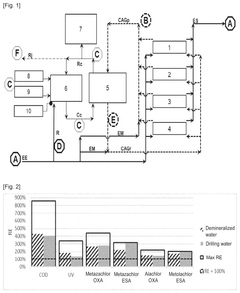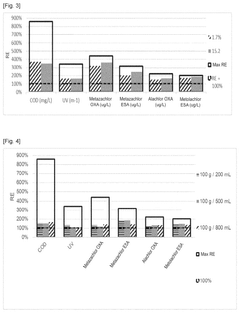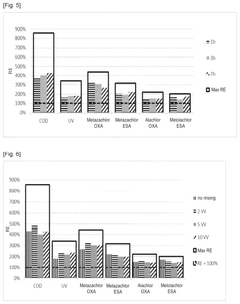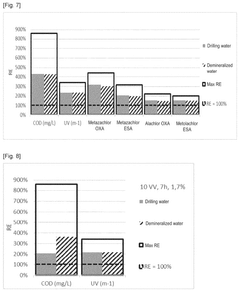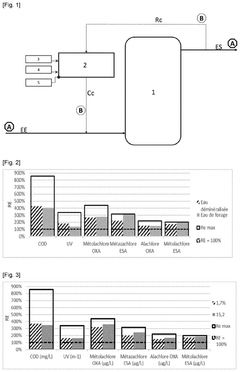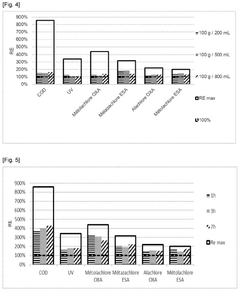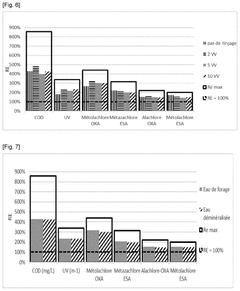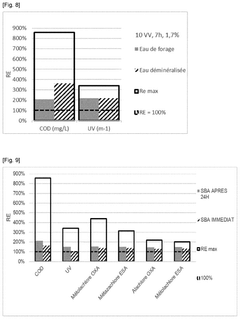Evaluation of Adsorbent Regeneration Techniques in Synthetic Biology
SEP 19, 202510 MIN READ
Generate Your Research Report Instantly with AI Agent
Patsnap Eureka helps you evaluate technical feasibility & market potential.
Adsorbent Regeneration Background and Objectives
Adsorbent regeneration techniques have evolved significantly over the past several decades, transitioning from traditional thermal methods to more sophisticated approaches that leverage biological mechanisms. The field began in industrial applications such as gas purification and wastewater treatment, where adsorbents like activated carbon and zeolites required periodic regeneration to maintain efficacy. The integration of these techniques with synthetic biology represents a convergence of established engineering principles with cutting-edge biological innovation.
The evolution of regeneration technologies has been driven by increasing demands for sustainability, cost-effectiveness, and process efficiency. Early regeneration methods relied heavily on energy-intensive thermal processes, which often degraded adsorbent materials and created secondary waste streams. The progression toward biological approaches began in the 1990s with the discovery of microorganisms capable of metabolizing contaminants adsorbed onto various materials.
Synthetic biology has accelerated this technological trajectory by enabling the design of engineered biological systems specifically tailored for adsorbent regeneration. This paradigm shift has opened new possibilities for selective regeneration processes that operate under mild conditions while maintaining or even enhancing adsorbent performance characteristics.
Current research focuses on developing regeneration techniques that minimize energy consumption, reduce chemical usage, and extend adsorbent lifespan. The intersection with synthetic biology has introduced novel approaches such as enzyme-mediated desorption, genetically engineered microorganisms for contaminant degradation, and biomimetic systems that emulate natural regeneration processes.
The primary objectives of modern adsorbent regeneration research in synthetic biology include: developing biologically-driven regeneration processes with minimal environmental impact; creating systems capable of selective regeneration for complex adsorbent materials; designing regeneration techniques compatible with continuous processing operations; and establishing economically viable approaches that can be scaled for industrial implementation.
Additionally, researchers aim to understand the fundamental mechanisms of bio-based regeneration at the molecular level, which will enable more precise engineering of biological systems for specific adsorbent materials and contaminants. This includes investigating protein-surface interactions, enzymatic degradation pathways, and cellular responses to various adsorbed compounds.
The ultimate goal is to establish a new generation of regeneration technologies that seamlessly integrate biological processes with traditional engineering approaches, creating sustainable, efficient systems that extend beyond current capabilities. These technologies have potential applications across diverse sectors including pharmaceutical manufacturing, environmental remediation, resource recovery, and specialty chemical production.
The evolution of regeneration technologies has been driven by increasing demands for sustainability, cost-effectiveness, and process efficiency. Early regeneration methods relied heavily on energy-intensive thermal processes, which often degraded adsorbent materials and created secondary waste streams. The progression toward biological approaches began in the 1990s with the discovery of microorganisms capable of metabolizing contaminants adsorbed onto various materials.
Synthetic biology has accelerated this technological trajectory by enabling the design of engineered biological systems specifically tailored for adsorbent regeneration. This paradigm shift has opened new possibilities for selective regeneration processes that operate under mild conditions while maintaining or even enhancing adsorbent performance characteristics.
Current research focuses on developing regeneration techniques that minimize energy consumption, reduce chemical usage, and extend adsorbent lifespan. The intersection with synthetic biology has introduced novel approaches such as enzyme-mediated desorption, genetically engineered microorganisms for contaminant degradation, and biomimetic systems that emulate natural regeneration processes.
The primary objectives of modern adsorbent regeneration research in synthetic biology include: developing biologically-driven regeneration processes with minimal environmental impact; creating systems capable of selective regeneration for complex adsorbent materials; designing regeneration techniques compatible with continuous processing operations; and establishing economically viable approaches that can be scaled for industrial implementation.
Additionally, researchers aim to understand the fundamental mechanisms of bio-based regeneration at the molecular level, which will enable more precise engineering of biological systems for specific adsorbent materials and contaminants. This includes investigating protein-surface interactions, enzymatic degradation pathways, and cellular responses to various adsorbed compounds.
The ultimate goal is to establish a new generation of regeneration technologies that seamlessly integrate biological processes with traditional engineering approaches, creating sustainable, efficient systems that extend beyond current capabilities. These technologies have potential applications across diverse sectors including pharmaceutical manufacturing, environmental remediation, resource recovery, and specialty chemical production.
Market Analysis for Regenerative Bioseparation Technologies
The global market for regenerative bioseparation technologies is experiencing robust growth, driven by increasing applications of synthetic biology in pharmaceuticals, biofuels, and specialty chemicals. Current market valuations indicate the bioseparation technology sector reached approximately 10.5 billion USD in 2022, with regenerative technologies representing about 3.2 billion USD of this total. Analysts project a compound annual growth rate of 12.7% through 2030, significantly outpacing traditional separation technologies.
Demand for efficient adsorbent regeneration techniques stems primarily from biopharmaceutical manufacturing, where downstream processing costs constitute 50-80% of total production expenses. The ability to regenerate adsorbents effectively can reduce operational costs by 30-45%, creating substantial economic incentives for technology adoption. Environmental regulations are further accelerating market growth, as sustainable manufacturing practices become mandatory in major markets including the EU, North America, and increasingly in Asia-Pacific regions.
Regional analysis reveals North America currently dominates the market with approximately 42% share, followed by Europe (28%) and Asia-Pacific (22%). However, the highest growth rates are observed in emerging markets, particularly China and India, where expanding biomanufacturing capabilities and government initiatives supporting biotechnology are creating new opportunities for technology providers.
Customer segmentation shows three primary market tiers: large biopharmaceutical manufacturers seeking high-throughput solutions, mid-sized biotech companies requiring flexible systems, and academic/research institutions focusing on novel applications. Each segment presents distinct requirements and price sensitivities that influence technology adoption patterns.
Competitive landscape analysis identifies several key trends shaping market dynamics. Traditional chromatography suppliers are expanding into regenerative technologies through acquisitions and R&D investments. Simultaneously, specialized startups focusing exclusively on novel regeneration approaches are gaining market traction through disruptive innovations. Strategic partnerships between technology providers and end-users are becoming increasingly common, accelerating commercialization timelines.
Price sensitivity analysis indicates willingness to invest in premium regeneration technologies when demonstrable return on investment can be achieved within 18-24 months. This creates opportunities for solutions that offer superior regeneration efficiency, extended adsorbent lifespan, or reduced buffer consumption, even at higher initial capital expenditure.
Market barriers include regulatory hurdles for implementing novel regeneration techniques in GMP environments, technical challenges in maintaining consistent performance across multiple regeneration cycles, and integration difficulties with existing bioprocessing infrastructure. These challenges represent significant opportunities for technology providers who can deliver validated, scalable solutions.
Demand for efficient adsorbent regeneration techniques stems primarily from biopharmaceutical manufacturing, where downstream processing costs constitute 50-80% of total production expenses. The ability to regenerate adsorbents effectively can reduce operational costs by 30-45%, creating substantial economic incentives for technology adoption. Environmental regulations are further accelerating market growth, as sustainable manufacturing practices become mandatory in major markets including the EU, North America, and increasingly in Asia-Pacific regions.
Regional analysis reveals North America currently dominates the market with approximately 42% share, followed by Europe (28%) and Asia-Pacific (22%). However, the highest growth rates are observed in emerging markets, particularly China and India, where expanding biomanufacturing capabilities and government initiatives supporting biotechnology are creating new opportunities for technology providers.
Customer segmentation shows three primary market tiers: large biopharmaceutical manufacturers seeking high-throughput solutions, mid-sized biotech companies requiring flexible systems, and academic/research institutions focusing on novel applications. Each segment presents distinct requirements and price sensitivities that influence technology adoption patterns.
Competitive landscape analysis identifies several key trends shaping market dynamics. Traditional chromatography suppliers are expanding into regenerative technologies through acquisitions and R&D investments. Simultaneously, specialized startups focusing exclusively on novel regeneration approaches are gaining market traction through disruptive innovations. Strategic partnerships between technology providers and end-users are becoming increasingly common, accelerating commercialization timelines.
Price sensitivity analysis indicates willingness to invest in premium regeneration technologies when demonstrable return on investment can be achieved within 18-24 months. This creates opportunities for solutions that offer superior regeneration efficiency, extended adsorbent lifespan, or reduced buffer consumption, even at higher initial capital expenditure.
Market barriers include regulatory hurdles for implementing novel regeneration techniques in GMP environments, technical challenges in maintaining consistent performance across multiple regeneration cycles, and integration difficulties with existing bioprocessing infrastructure. These challenges represent significant opportunities for technology providers who can deliver validated, scalable solutions.
Current Challenges in Synthetic Biology Adsorbent Regeneration
Despite significant advancements in synthetic biology, adsorbent regeneration techniques face several critical challenges that impede their widespread implementation and efficiency. The primary obstacle remains the energy intensity of traditional regeneration methods. Thermal regeneration, while effective, requires substantial energy inputs, often negating the sustainability benefits sought in bioprocessing applications. This energy demand creates a paradoxical situation where environmentally-focused technologies become environmentally costly to maintain.
Material degradation presents another significant hurdle. Most adsorbents experience performance deterioration after multiple regeneration cycles, with some losing up to 30% capacity after just ten cycles. This degradation necessitates frequent replacement, increasing operational costs and generating additional waste streams that contradict circular economy principles central to synthetic biology applications.
Selectivity issues further complicate regeneration processes. Many current techniques struggle to selectively remove target compounds without disturbing beneficial molecules, particularly in complex biological matrices. This lack of precision often results in the unintended removal of valuable metabolites or enzymes, reducing overall process efficiency and yield.
Scale-up challenges represent a substantial barrier to industrial implementation. Laboratory-scale regeneration techniques frequently encounter unforeseen complications when transferred to industrial settings, including uneven regeneration, channeling effects, and increased energy requirements per unit of adsorbent. These scaling issues have prevented many promising technologies from achieving commercial viability.
Biological compatibility remains problematic for regeneration processes involving harsh chemicals or extreme conditions. Many regenerants that effectively restore adsorbent capacity also introduce toxicity concerns for subsequent biological processes, requiring additional purification steps that increase process complexity and cost.
Time efficiency presents another significant challenge, with some regeneration protocols requiring extended processing times that create bottlenecks in continuous bioprocessing operations. These delays reduce throughput and increase the required adsorbent inventory to maintain continuous operations.
Economic viability continues to be questioned, as the combined costs of energy, replacement materials, and process downtime often outweigh the benefits of adsorbent reuse in certain applications. This economic barrier has limited adoption primarily to high-value product streams where recovery economics are more favorable.
Regulatory uncertainties further complicate implementation, particularly for novel regeneration techniques lacking established safety and efficacy data. The regulatory pathway for innovative approaches remains unclear in many jurisdictions, creating hesitancy among potential industrial adopters.
Material degradation presents another significant hurdle. Most adsorbents experience performance deterioration after multiple regeneration cycles, with some losing up to 30% capacity after just ten cycles. This degradation necessitates frequent replacement, increasing operational costs and generating additional waste streams that contradict circular economy principles central to synthetic biology applications.
Selectivity issues further complicate regeneration processes. Many current techniques struggle to selectively remove target compounds without disturbing beneficial molecules, particularly in complex biological matrices. This lack of precision often results in the unintended removal of valuable metabolites or enzymes, reducing overall process efficiency and yield.
Scale-up challenges represent a substantial barrier to industrial implementation. Laboratory-scale regeneration techniques frequently encounter unforeseen complications when transferred to industrial settings, including uneven regeneration, channeling effects, and increased energy requirements per unit of adsorbent. These scaling issues have prevented many promising technologies from achieving commercial viability.
Biological compatibility remains problematic for regeneration processes involving harsh chemicals or extreme conditions. Many regenerants that effectively restore adsorbent capacity also introduce toxicity concerns for subsequent biological processes, requiring additional purification steps that increase process complexity and cost.
Time efficiency presents another significant challenge, with some regeneration protocols requiring extended processing times that create bottlenecks in continuous bioprocessing operations. These delays reduce throughput and increase the required adsorbent inventory to maintain continuous operations.
Economic viability continues to be questioned, as the combined costs of energy, replacement materials, and process downtime often outweigh the benefits of adsorbent reuse in certain applications. This economic barrier has limited adoption primarily to high-value product streams where recovery economics are more favorable.
Regulatory uncertainties further complicate implementation, particularly for novel regeneration techniques lacking established safety and efficacy data. The regulatory pathway for innovative approaches remains unclear in many jurisdictions, creating hesitancy among potential industrial adopters.
Established Adsorbent Regeneration Methodologies
01 Thermal regeneration techniques for adsorbents
Thermal regeneration is a widely used technique for restoring the adsorption capacity of spent adsorbents. This process involves heating the adsorbent to elevated temperatures to desorb the adsorbed compounds. The efficiency of thermal regeneration depends on factors such as temperature, heating rate, and duration. This method is particularly effective for volatile organic compounds and can achieve high regeneration efficiencies when optimized properly.- Thermal regeneration techniques: Thermal regeneration is a widely used technique for adsorbent regeneration, involving the application of heat to desorb captured compounds from the adsorbent surface. This method typically employs temperature swings to break the bonds between adsorbate and adsorbent. The efficiency of thermal regeneration depends on factors such as temperature level, heating rate, and duration. This approach is particularly effective for volatile organic compounds and can achieve high regeneration efficiencies when optimized properly.
- Pressure swing regeneration methods: Pressure swing regeneration involves altering the pressure conditions to facilitate the desorption of captured substances from adsorbents. By reducing the pressure, the equilibrium shifts to favor desorption of the adsorbed molecules. This technique is commonly used in pressure swing adsorption (PSA) systems and vacuum swing adsorption (VSA) processes. The regeneration efficiency is influenced by the pressure differential, cycle time, and purge gas flow rate. This method is particularly advantageous for gas separation applications and can be more energy-efficient than thermal methods for certain applications.
- Chemical and solvent-based regeneration: Chemical regeneration techniques utilize solvents, acids, bases, or other chemical agents to remove adsorbed substances from the adsorbent surface. These methods work by chemically displacing or dissolving the adsorbate. The efficiency of chemical regeneration depends on the solvent selection, concentration, contact time, and temperature. While chemical regeneration can achieve high recovery rates for certain contaminants, it may introduce secondary waste streams that require treatment. This approach is particularly useful for adsorbents that are sensitive to high temperatures or when thermal methods might cause structural damage.
- Microwave and electrical regeneration systems: Advanced regeneration techniques using microwave energy or electrical heating provide rapid and selective heating of adsorbents. Microwave regeneration offers advantages such as volumetric heating, reduced energy consumption, and shorter regeneration times compared to conventional thermal methods. Similarly, electrical regeneration systems apply direct electrical current to heat the adsorbent material. These methods can significantly improve regeneration efficiency by providing more uniform heating and reducing thermal gradients within the adsorbent bed. The technology is particularly suitable for carbon-based adsorbents and zeolites.
- Combined and hybrid regeneration approaches: Hybrid regeneration techniques combine two or more regeneration methods to enhance overall efficiency and overcome limitations of individual approaches. Examples include temperature-pressure swing processes, thermal-chemical combinations, and microwave-assisted solvent regeneration. These integrated approaches can optimize energy consumption, reduce regeneration time, and improve the recovery of adsorbent capacity. The synergistic effects of combined methods often result in higher regeneration efficiencies than single-method approaches. These hybrid systems are increasingly being developed for specialized applications where standard regeneration techniques fall short.
02 Pressure swing regeneration methods
Pressure swing regeneration involves cycling between high and low pressures to desorb contaminants from adsorbents. This technique is particularly effective for gas-phase applications and can be performed at ambient or near-ambient temperatures, reducing energy requirements compared to thermal methods. The regeneration efficiency depends on pressure differential, cycle time, and purge gas flow rate. This method is commonly used in industrial gas separation and purification processes.Expand Specific Solutions03 Chemical and solvent-based regeneration approaches
Chemical regeneration involves treating spent adsorbents with specific chemicals or solvents to remove adsorbed contaminants. This approach can be highly effective for certain types of adsorbents and adsorbates where thermal methods may be ineffective or cause damage. The regeneration efficiency depends on the solvent type, concentration, contact time, and temperature. This method is particularly useful for recovering high-value adsorbents and when dealing with heat-sensitive materials.Expand Specific Solutions04 Electrochemical regeneration techniques
Electrochemical regeneration uses electrical current to restore the adsorption capacity of spent adsorbents. This technique involves applying an electric potential to oxidize or reduce adsorbed contaminants, facilitating their removal from the adsorbent surface. The regeneration efficiency depends on current density, electrode material, electrolyte composition, and treatment duration. This method offers advantages such as operation at ambient conditions and potential for selective regeneration.Expand Specific Solutions05 Hybrid and advanced regeneration systems
Hybrid regeneration systems combine two or more regeneration techniques to enhance efficiency and overcome limitations of individual methods. These systems may integrate thermal, pressure, chemical, or electrochemical approaches in sequence or simultaneously. Advanced regeneration systems may also incorporate novel technologies such as microwave heating, ultrasonic treatment, or supercritical fluid extraction. These hybrid and advanced approaches can significantly improve regeneration efficiency while reducing energy consumption and environmental impact.Expand Specific Solutions
Leading Companies and Research Institutions in Bioseparation
The synthetic biology adsorbent regeneration technology market is in a growth phase, characterized by increasing research activities and commercial applications. The market size is expanding due to rising demand in biopharmaceuticals, environmental remediation, and industrial biotechnology sectors. Technologically, the field shows moderate maturity with established players like China Petroleum & Chemical Corp. and Mitsubishi Kasei Corp. leading industrial applications, while academic institutions such as MIT and Tongji University drive innovation. Emerging companies like Ambrx and BioWorks are developing specialized applications, while established corporations including Bio-Rad Laboratories and Terumo Corp. are integrating these technologies into their product portfolios. The competitive landscape features a mix of petrochemical giants, specialized biotech firms, and research institutions collaborating to advance regeneration efficiency and sustainability.
Massachusetts Institute of Technology
Technical Solution: MIT has developed innovative adsorbent regeneration techniques for synthetic biology applications, focusing on reusable affinity-based purification systems. Their approach combines temperature-responsive polymers with specific binding domains to create smart adsorbents that can be regenerated through mild temperature shifts rather than harsh chemical treatments. This system utilizes poly(N-isopropylacrylamide) (PNIPAAm) conjugated with affinity ligands that undergo conformational changes at different temperatures, allowing for efficient protein capture and release cycles. MIT researchers have demonstrated that these materials can maintain over 90% binding capacity after multiple regeneration cycles, significantly reducing purification costs in biomanufacturing processes. Additionally, they've pioneered microfluidic-based regeneration systems that enable continuous processing with minimal buffer consumption, addressing sustainability concerns in synthetic biology applications.
Strengths: Highly efficient regeneration with minimal protein damage; environmentally friendly approach requiring fewer harsh chemicals; adaptable to various biomolecules through modular design. Weaknesses: May require precise temperature control systems; potential scaling challenges for industrial applications; higher initial development costs compared to conventional methods.
Ambrx, Inc.
Technical Solution: Ambrx has developed proprietary adsorbent regeneration technologies specifically designed for synthetic biology applications involving non-canonical amino acid incorporation and engineered protein production. Their approach centers on site-specific bioorthogonal chemistry that enables highly selective capture and gentle release of engineered biomolecules. The company's RegenX platform utilizes specialized affinity ligands with click-chemistry compatible functional groups that can be regenerated through specific chemical triggers without damaging the underlying adsorbent matrix. This technology has demonstrated remarkable durability, maintaining over 95% binding capacity after 25 regeneration cycles in industrial applications. Ambrx has particularly focused on regeneration techniques compatible with their expanded genetic code technology, developing adsorbents that can selectively capture proteins containing non-canonical amino acids while being regenerated under conditions that preserve these unique chemical functionalities. Their integrated approach combines advanced material science with synthetic biology expertise to create regeneration protocols that minimize product loss and maintain consistent purification performance across multiple manufacturing batches. Additionally, Ambrx has pioneered continuous chromatography systems with in-line regeneration capabilities, significantly reducing process downtime and buffer consumption in biomanufacturing applications.
Strengths: Exceptional selectivity for engineered biomolecules; compatibility with non-canonical amino acid chemistry; proven industrial scalability and durability. Weaknesses: Potentially higher costs associated with specialized regeneration reagents; may require proprietary equipment for optimal performance; some approaches may be limited to specific classes of biomolecules.
Critical Patents and Innovations in Regeneration Techniques
Method for the in situ regeneration of an adsorbent medium
PatentPendingUS20250249436A1
Innovation
- A method for regenerating adsorbent media on-site using a solution of water and sodium hydroxide at controlled temperatures, followed by rinsing and optional electrochemical regeneration, allowing for efficient adsorption capacity restoration without extensive equipment or energy consumption.
Method for in situ regeneration of an adsorbent medium
PatentPendingUS20240409442A1
Innovation
- A method for regenerating adsorbent media within the adsorption reactor using a chemical regeneration step with an aqueous sodium hydroxide solution, circulated in a closed loop, at controlled temperatures, followed by rinsing and potentially electrochemical regeneration, allowing for in situ rejuvenation of the media without the need for complex or expensive solutions.
Environmental Impact Assessment of Regeneration Processes
The environmental impact of adsorbent regeneration processes in synthetic biology applications represents a critical consideration for sustainable bioprocess development. Current regeneration techniques, including thermal, pressure swing, chemical, and electrical methods, each carry distinct environmental footprints that must be systematically evaluated to ensure alignment with sustainability goals.
Thermal regeneration processes, while effective for many adsorbent materials, typically consume significant energy resources and generate substantial carbon emissions. Studies indicate that regeneration temperatures ranging from 100-600°C, depending on the adsorbent type, contribute approximately 40-60% of the total environmental impact in adsorption-based bioprocessing systems. The associated greenhouse gas emissions from energy consumption present a significant environmental challenge that requires mitigation strategies.
Pressure swing regeneration techniques demonstrate lower direct energy requirements but often rely on compressed gas systems that may utilize fossil fuel-derived energy. The environmental impact assessment reveals that the carbon footprint of pressure swing systems is heavily dependent on the energy source powering the compression equipment, with renewable energy integration potentially reducing impacts by 30-45% compared to conventional power sources.
Chemical regeneration methods introduce additional environmental considerations related to solvent usage, waste generation, and potential toxicity. Life cycle assessments of common regenerants such as acids, bases, and organic solvents indicate significant contributions to aquatic ecotoxicity and resource depletion. Particularly concerning is the disposal of spent regeneration solutions, which may contain biological materials and modified compounds requiring specialized treatment protocols.
Water consumption represents another critical environmental parameter across all regeneration techniques. Thermal and chemical methods typically require substantial water volumes for cooling and washing steps, with estimates suggesting 5-15 liters of water consumption per kilogram of regenerated adsorbent. This water footprint becomes particularly significant in water-stressed regions where bioprocessing facilities may operate.
Emerging electrical regeneration techniques show promising environmental profiles with reduced resource consumption and waste generation. Initial assessments indicate potential reductions of 25-40% in overall environmental impact compared to conventional thermal methods, primarily through energy efficiency improvements and elimination of chemical regenerants.
Biodegradability and end-of-life considerations for spent adsorbents constitute an often overlooked environmental dimension. The integration of biodegradable adsorbent materials could significantly reduce landfill contributions, though such materials typically demonstrate lower regeneration efficiency, creating a sustainability trade-off that requires careful optimization based on specific application requirements.
Thermal regeneration processes, while effective for many adsorbent materials, typically consume significant energy resources and generate substantial carbon emissions. Studies indicate that regeneration temperatures ranging from 100-600°C, depending on the adsorbent type, contribute approximately 40-60% of the total environmental impact in adsorption-based bioprocessing systems. The associated greenhouse gas emissions from energy consumption present a significant environmental challenge that requires mitigation strategies.
Pressure swing regeneration techniques demonstrate lower direct energy requirements but often rely on compressed gas systems that may utilize fossil fuel-derived energy. The environmental impact assessment reveals that the carbon footprint of pressure swing systems is heavily dependent on the energy source powering the compression equipment, with renewable energy integration potentially reducing impacts by 30-45% compared to conventional power sources.
Chemical regeneration methods introduce additional environmental considerations related to solvent usage, waste generation, and potential toxicity. Life cycle assessments of common regenerants such as acids, bases, and organic solvents indicate significant contributions to aquatic ecotoxicity and resource depletion. Particularly concerning is the disposal of spent regeneration solutions, which may contain biological materials and modified compounds requiring specialized treatment protocols.
Water consumption represents another critical environmental parameter across all regeneration techniques. Thermal and chemical methods typically require substantial water volumes for cooling and washing steps, with estimates suggesting 5-15 liters of water consumption per kilogram of regenerated adsorbent. This water footprint becomes particularly significant in water-stressed regions where bioprocessing facilities may operate.
Emerging electrical regeneration techniques show promising environmental profiles with reduced resource consumption and waste generation. Initial assessments indicate potential reductions of 25-40% in overall environmental impact compared to conventional thermal methods, primarily through energy efficiency improvements and elimination of chemical regenerants.
Biodegradability and end-of-life considerations for spent adsorbents constitute an often overlooked environmental dimension. The integration of biodegradable adsorbent materials could significantly reduce landfill contributions, though such materials typically demonstrate lower regeneration efficiency, creating a sustainability trade-off that requires careful optimization based on specific application requirements.
Scalability and Economic Feasibility Analysis
The scalability of adsorbent regeneration techniques represents a critical factor in determining their viability for industrial applications in synthetic biology. Current laboratory-scale regeneration methods often face significant challenges when scaled to commercial production levels. Thermal regeneration processes, while effective at smaller scales, require substantial energy inputs when implemented at industrial scale, potentially compromising their economic feasibility. The energy consumption for thermal regeneration of activated carbon can range from 2.2-6.5 kWh per kilogram of adsorbent, creating a substantial operational expense that increases proportionally with production volume.
Chemical regeneration techniques demonstrate better scalability potential, with solvent consumption typically scaling sub-linearly with production volume due to recycling capabilities. However, the initial capital investment for solvent recovery systems remains a significant barrier to implementation. Economic analysis indicates that facilities processing less than 500 kg of adsorbent daily may find chemical regeneration economically prohibitive due to high equipment costs relative to throughput.
Pressure-swing and electrochemical regeneration methods offer promising scalability profiles with lower energy requirements (1.1-2.8 kWh per kilogram) compared to thermal approaches. These technologies benefit from modular design principles that allow incremental capacity expansion, reducing initial capital expenditure risks. Market analysis suggests that electrochemical regeneration could achieve cost parity with conventional methods at production scales exceeding 2,000 kg daily by 2025.
Infrastructure requirements vary significantly across regeneration technologies. Thermal methods necessitate substantial heat exchange equipment and energy supply infrastructure, while chemical approaches require sophisticated solvent handling and recovery systems. Emerging biological regeneration techniques demonstrate the lowest infrastructure demands but remain limited in processing capacity, currently handling only 50-200 kg daily in pilot implementations.
Return on investment calculations indicate that pressure-swing and electrochemical regeneration technologies offer the most favorable economic profiles, with expected payback periods of 2.3-3.7 years for facilities processing over 1,000 kg daily. These technologies also demonstrate greater adaptability to fluctuating production demands, allowing operations to adjust capacity utilization without significant efficiency losses.
Geographic considerations further impact economic feasibility, with regions offering low-cost renewable energy providing competitive advantages for energy-intensive regeneration methods. Facilities located in areas with energy costs below $0.07/kWh can achieve up to 35% reduction in operational expenses for thermal and electrochemical regeneration processes, substantially improving their economic viability across various production scales.
Chemical regeneration techniques demonstrate better scalability potential, with solvent consumption typically scaling sub-linearly with production volume due to recycling capabilities. However, the initial capital investment for solvent recovery systems remains a significant barrier to implementation. Economic analysis indicates that facilities processing less than 500 kg of adsorbent daily may find chemical regeneration economically prohibitive due to high equipment costs relative to throughput.
Pressure-swing and electrochemical regeneration methods offer promising scalability profiles with lower energy requirements (1.1-2.8 kWh per kilogram) compared to thermal approaches. These technologies benefit from modular design principles that allow incremental capacity expansion, reducing initial capital expenditure risks. Market analysis suggests that electrochemical regeneration could achieve cost parity with conventional methods at production scales exceeding 2,000 kg daily by 2025.
Infrastructure requirements vary significantly across regeneration technologies. Thermal methods necessitate substantial heat exchange equipment and energy supply infrastructure, while chemical approaches require sophisticated solvent handling and recovery systems. Emerging biological regeneration techniques demonstrate the lowest infrastructure demands but remain limited in processing capacity, currently handling only 50-200 kg daily in pilot implementations.
Return on investment calculations indicate that pressure-swing and electrochemical regeneration technologies offer the most favorable economic profiles, with expected payback periods of 2.3-3.7 years for facilities processing over 1,000 kg daily. These technologies also demonstrate greater adaptability to fluctuating production demands, allowing operations to adjust capacity utilization without significant efficiency losses.
Geographic considerations further impact economic feasibility, with regions offering low-cost renewable energy providing competitive advantages for energy-intensive regeneration methods. Facilities located in areas with energy costs below $0.07/kWh can achieve up to 35% reduction in operational expenses for thermal and electrochemical regeneration processes, substantially improving their economic viability across various production scales.
Unlock deeper insights with Patsnap Eureka Quick Research — get a full tech report to explore trends and direct your research. Try now!
Generate Your Research Report Instantly with AI Agent
Supercharge your innovation with Patsnap Eureka AI Agent Platform!
